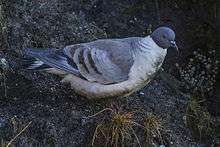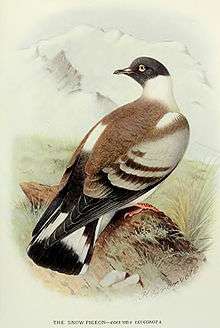Snow pigeon
| Snow pigeon | |
|---|---|
 | |
| Snow pigeon from Sikkim, India. | |
| Scientific classification | |
| Kingdom: | Animalia |
| Phylum: | Chordata |
| Class: | Aves |
| Order: | Columbiformes |
| Family: | Columbidae |
| Genus: | Columba |
| Species: | C. leuconota |
| Binomial name | |
| Columba leuconota Vigors, 1831 | |
The snow pigeon (Columba leuconota) is a species of bird in the Columba genus in the family Columbidae from hilly regions of central Asia. They are grey, black, pale brown and white birds, and two races are recognised; C. l. leuconota occurs in Afghanistan and the western Himalayas; C. l. gradaria occurs in the mountains of East Tibet and from East Nan Shan (Qinghai) to Yunnan. The birds forage in open country in pairs or small groups, feeding on grain, buds, shoots, berries and seeds. They roost at night on cliffs, breeding in crevices where they build untidy stick nests and lay a clutch of usually two white eggs. The International Union for Conservation of Nature has rated the bird's conservation status as being of "least concern".
Description

Snow pigeons have a blackish head contrasting with white neck collar and white underparts shading into ashy on the abdomen. Their backs are brownish grey with a white patch on the lower back. Their wings are pale grey with three brown bands. Their black tails have a clear white band in the middle which narrows and curve forward to reach the tip of outermost tail features. Young birds have narrow pale buff margins to the feathers of the upper parts and wings. The white of the underparts is sullied with buff.[2][3]
Taxonomy and systematics
Two races are recognized:
- leuconota described by Vigors in 1831 is found in Himalayas from West Afghanistan to Sikkim; summer visitor to Alay Mountains and Pamir.
- gradaria described by Hartert in 1916 is found in mountains of East Tibet and from East Nan Shan (Qinghai) to Yunnan and extreme N Myanmar.
Distribution and status
They are resident birds in rocky hills of Afghanistan, Bhutan, China, India, Kazakhstan, Myanmar, Nepal, Pakistan, Tajikistan, and Turkmenistan. It is a common bird and has an extremely large range. The population is believed to be stable, and for these reasons, the International Union for Conservation of Nature has assessed its conservation status as being of "least concern".[1]
Behaviour and ecology
They frequent rocky hill sides and sequestered valleys, seen up to the snow line. They frequently feed in the fields during the day, but roost in the cliffs. They are generally shy and wary. Gatherings of 150 or more occur in winter, often in company of hill pigeon and in some areas with rock pigeon too.[4]

In the summer, they descend to lower heights and are found in pairs or small flocks. They breed in colonies. The nests are placed in crevices or caves in the face of cliffs or ledges of rock. Their nests are untidy interlaced structures made of sticks, grass, straw, feathers etc. The nests are generally reused every year with minor repairing. Generally two eggs are laid.[3]
They feed on berries, grain, buds, bulbs, seeds, and shoots.[3]
References
- 1 2 BirdLife International (2012). "Columba leuconota". IUCN Red List of Threatened Species. Version 2013.2. International Union for Conservation of Nature. Retrieved 26 November 2013.
- ↑ Rasmussen PC & JC Anderton (2005). Birds of South Asia: The Ripley Guide. Volume 2. Smithsonian Institution & Lynx Edicions. p. 204.
- 1 2 3 Baker, ECS (1928). Fauna of British India. Birds. Volume 5 (2nd ed.). Taylor and Francis, London. pp. 224–225.
- ↑ Gibbs, David; Eustace Barnes; John Cox. Pigeons and Doves: A Guide to the Pigeons and Doves of the World. United Kingdom: Pica Press. p. 624. ISBN 1-873403-60-7.
